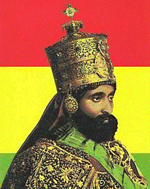This Day in History: July 23, 1892
Additional Date: July 23, 1892
Haile Selassi was born as Lij Tafari Makonnen in the village of Ejersa Gor, in the Harar province of Ethiopia. Heir to a 13th century dynasty, he ascended to the throne of Ethiopia in 1930, proclaiming himself "Haile Selassi", which means "Might of the Trinity". In 1936, he led his countries resistance to Italy's invasion of Ethiopia and also spoke out against the use of chemical weapons at the League of Nations. Exiled to England in 1936, he was restored to power in 1941. However, by the 1970s, his apparent indifference to the Wollo famine resulted in the loss of popular support. In 1974, he was dethroned in a military coup and murdered by his successor, Mengistu Haile Mariam. Selassi has been criticised for his suppression of Ethiopian nobles and for his inability to modernise Ethiopia. However, he was also looked up to as a symbol of African dignity, both within and outside the continent. Rastafarians revere Selassi as a god that will unify the African Diaspora and lead them into an age of peace and prosperity. Rastafarianism has a following of between 200 000 to 800 000 world-wide. The largest Rastafarian community in South Africa is situated in Knysna and comprises of 30 families
